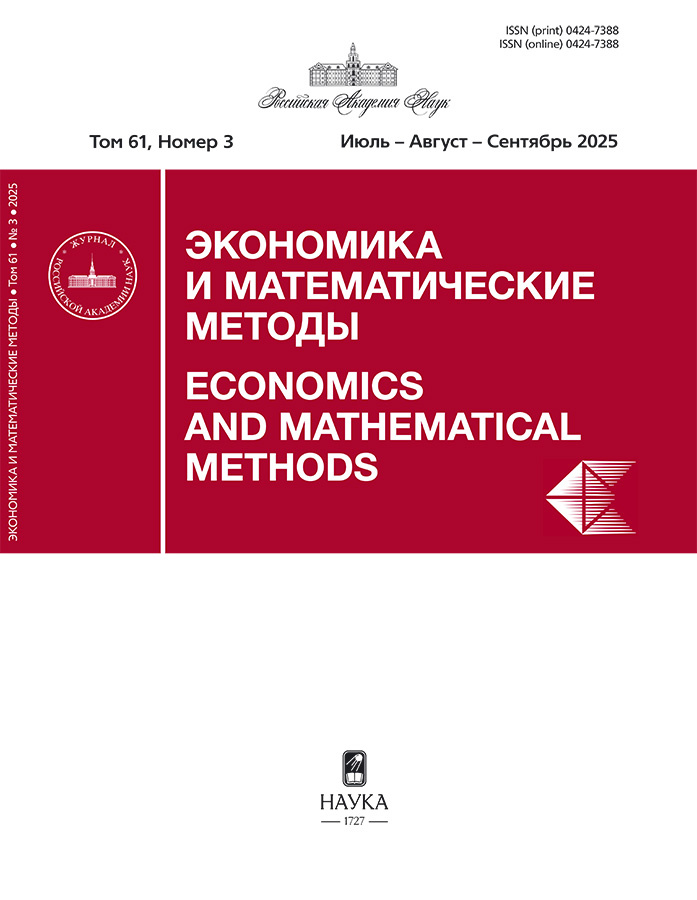Вопросы балансирования экономического роста с состоянием среды обитания
- Авторы: Фальцман В.К.1
-
Учреждения:
- ИПЭИ РАНХиГС
- Выпуск: Том 59, № 2 (2023)
- Страницы: 112-121
- Раздел: Статьи
- URL: https://transsyst.ru/0424-7388/article/view/653345
- DOI: https://doi.org/10.31857/S042473880025863-8
- ID: 653345
Цитировать
Полный текст
Аннотация
Статья посвящена фундаментальной проблеме экономического роста — каким условиям должен отвечать рост, чтобы обеспечить благосостояние быстро растущего населения мира и одновременно сохранить природную среду обитания для будущих поколений. Безусловным приоритетом роста мировой экономики в ХХI в. должно стать сохранение среды обитания, включая климат. Для формализации природоохранного типа экономического роста в неявном виде предложена производственная функция, в которой выделен фактор сохранения среды обитания, сдерживающий рост. В целях замедления роста антропогенной нагрузки на среду обитания, наряду с природоохранными мерами и технологиями, по-видимому, предстоит вынужденное снижение темпов роста численности населения развивающихся стран и мира в целом. Нынешний быстрый рост населения должен быть сбалансирован с ресурсами жизнеобеспечения стран, в том числе — природными. Анализируются три концепции экономического роста: классическая — максимального роста, нулевого роста и предложенная в статье концепция сбалансированного роста, реализация которой предполагает верхний и нижний пределы роста. Рассмотрены необходимые предпосылки сбалансированного роста. Для сбалансированного роста населения развивающихся стран предстоит сократить их опасное отставание от стран развитого мира по индексу человеческого развития, обеспечив опережающий рост их ВВП на душу населения. Регулирование роста численности населения может стать объектом международного соглашения и, видимо, потребует дополнительной целевой международной помощи слаборазвитым странам.
Список литературы
- Кузнец С. (2004). Современный экономический рост: результаты исследования и размышления. В кн.: «Мировая экономическая мысль». Т. 5. «Всемирное признание. Лекции нобелевских лауреатов». Отв. ред. Г.Г. Фетисов. М.: Мысль. С. 106–124.
- Мюрдаль Г. (2004). Проблема равновесия и ее роль в мировом развитии. В кн.: «Мировая экономическая мысль». Т. 5. «Всемирное признание. Лекции нобелевских лауреатов». Отв. ред. Г.Г. Фетисов. М.: Мысль. С. 189–214.
- Самуэльсон П.А. (2004). Принципы максимума в экономическом анализе. В кн.: «Мировая экономическая мысль». Т. 5. «Всемирное признание. Лекции нобелевских лауреатов». Отв. ред. Г.Г. Фетисов. М.: Мысль. С. 87–106.]
- Солоу Р. (2004). Теория роста и дискуссия о ней. В кн.: «Мировая экономическая мысль». Т. 5. «Всемирное признание. Лекции нобелевских лауреатов». Отв. ред. Г.Г. Фетисов. М.: Мысль. С. 574–593.
- Фальцман В.К. (2020). Международная помощь беднейшим странам // Мировая экономика и международные отношения. Т. 64. № 8. С. 56–62.
- Фальцман В.К. (2021). Регулирование антропогенной нагрузки на среду обитания // Миро-вая экономика и международные отношения. Том 65, №4. С. 14–20.
- Фальцман В.К. (2022). Перспективы повышения индекса человеческого развития // Мировая экономика и международные отношения. Том 66, №9. С. 47–53.
- Фитуни Л.Л. (2012). Африка: ресурсные войны ХХI века на Африканском континенте // Ин-ститут Африки РАН. С. 248.
- Economic growth in the Future. The Growth Debate in National and Global Perspective (1976). Edison Electric Institute, McGraw-Hill Book Company, 82–134.
- Kuznets S. (1971). Economic Growth of Nations: Total Output and Production Structure. Cam-bridge: Harvard University Press, 10–27.
Дополнительные файлы











